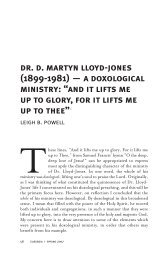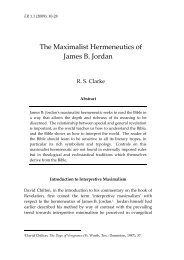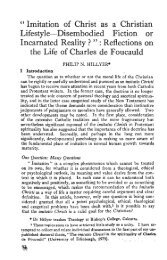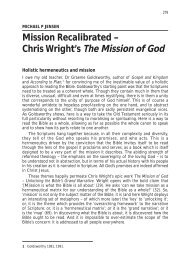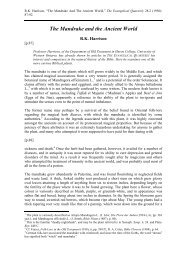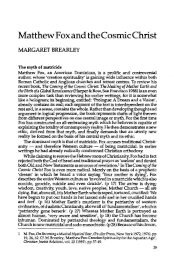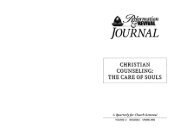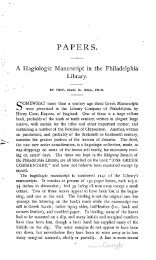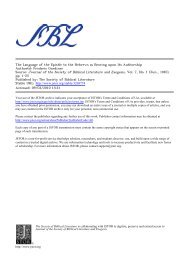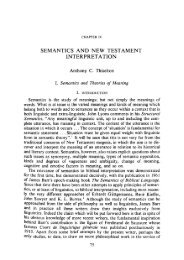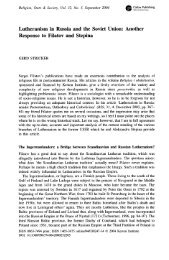Ancient Orient and Old Testament - BiblicalStudies.org.uk
Ancient Orient and Old Testament - BiblicalStudies.org.uk
Ancient Orient and Old Testament - BiblicalStudies.org.uk
You also want an ePaper? Increase the reach of your titles
YUMPU automatically turns print PDFs into web optimized ePapers that Google loves.
K.A. Kitchen, <strong>Ancient</strong> <strong>Orient</strong> <strong>and</strong> <strong>Old</strong> <strong>Testament</strong>. London: Inter-Varsity Press, 1966. Hbk. pp.191.<br />
[p.79]<br />
4. SOME HISTORICAL PROBLEMS<br />
I. ALLEGED ANACHRONISMS<br />
(a) Camels in the Patriarchal Age<br />
It is often asserted that the mention of camels <strong>and</strong> of their use is an anachronism in Genesis. 1 This<br />
charge is simply not true, as there is both philological <strong>and</strong> archaeological evidence for knowledge<br />
<strong>and</strong> use of this animal in the early second millennium BC <strong>and</strong> even earlier. While a possible<br />
reference to camels in a fodder-list from Alalakh (c. eighteenth century BC) 2 has been disputed, 3<br />
the great Mesopotamian lexical lists that originated in the <strong>Old</strong> Babylonian period show a<br />
knowledge of the camel c. 2000/1700 BC, including its domestication. 4 Furthermore, a<br />
Sumerian text from Nippur from the same early period gives clear evidence of domestication of<br />
the camel by then, by its allusions to camel’s milk. 5 Camel bones were found in houseruins at<br />
Mari of the pre-Sargonic age (twenty-fifth to twenty-fourth centuries BC), 6 <strong>and</strong> also in various<br />
Palestinian sites from<br />
[p.80]<br />
2000 to 1200 BC. 7 From Byblos comes an incomplete camel-figurine of the nineteenth/eighteenth<br />
centuries BC. 8 This <strong>and</strong> a variety of other evidence cannot be lightly disregarded. 9 For the early <strong>and</strong><br />
middle second millennium BC, only limited use is presupposed by either the biblical or external<br />
evidence until the twelfth century BC.<br />
1 Cf. Albright, JBL 64 (1945), pp. 287 - 288; ZAW 62 (1950), p. 315; The Archaeology of Palestine 4 , 1960, pp.<br />
206-207, Also J. Bright, A History of Israel, 1960, pp. 72-73, <strong>and</strong> O. Eissfeldt, CAH 2 , II: 26a (Palestine in the<br />
Nineteenth Dynasty ... ), 1965, p. 6.<br />
2 D. J. Wiseman <strong>and</strong> A. Goetze, JCS 13 (1959), pp. 29, 37.<br />
3 By W. G. Lambert, BASOR 160 (1960), P. 42. No final decision can be reached until the original cuneiform<br />
tablet has been re-collated by someone competent in the Alalakh script-forms <strong>and</strong> without interests in the<br />
presence/absence of camels in this period.<br />
4 See Lambert, op. cit., pp. 42-43, who has to admit that the natural implication of the contexts is that of a<br />
domesticated animal.<br />
5 See the Chicago Assyrian Dictionary, 7/1-J, 1960, p. 2b under ibilu <strong>and</strong> reference to text Ni (ppur) 9602:94 f. I<br />
owe this reference to the kindness of Mr. A. R. Millard. Jacobsen’s reading has not been taken up by S. N.<br />
Kramer, Proc. APS 107: 6 (1963), pp. 506-507, iii: 24-26.<br />
6 A. Parrot, Syria 32 (1955) p. 323.<br />
7 See, for example, R. de Vaux, RB 56 (1949), p. g (=Die hebraischen Patriarchen <strong>and</strong> die modernen<br />
Entdeckungen, 1961, p. 59), <strong>and</strong> B. S. J. Isserlin, PEQ 82 (1950), pp. 50 - 53.<br />
8 See de Vaux, RB 56 (1949), p. 9 n. 5 (= Die hebr. Patr., p. 59 n. 5); K. A. Kitchen, JEA 47 (1961), p. 159 n.<br />
1, or NBD, p. 182.<br />
9 A fuller treatment is to appear in Kitchen, The Joseph Narrative <strong>and</strong> its Egyptian Background (forthcoming).<br />
The most recent collection of the archaeological data is by B. Brentjes, Klio 38 (1960), pp. 23-52. Hitherto, the<br />
most valuable such surveys have been those by R. Walz, ZDMG 101 (1951), pp. 29-51; ZDMG 104 (1954), pp.<br />
45 - 87; Actes du IVe Congés Internationale des Sciences Anthropologiques et Ethnologiques, III, Vienna,<br />
1956, pp. 190-204.




